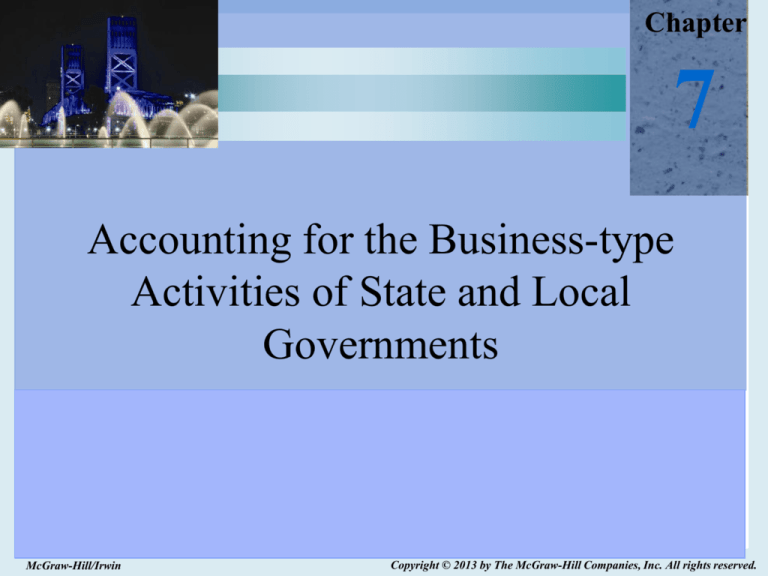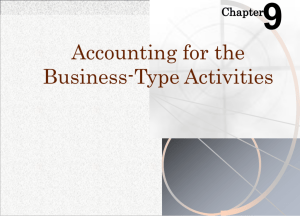
Chapter
7
Accounting for the Business-type
Activities of State and Local
Governments
McGraw-Hill/Irwin
Copyright © 2013 by The McGraw-Hill Companies, Inc. All rights reserved.
Learning Objectives
After studying Chapter 7, you should be able to:
Describe the characteristics of proprietary funds,
including those unique to internal service and enterprise
funds
Distinguish between the purposes of internal service
funds and enterprise funds
Explain the financial reporting requirements, including
the differences between the reporting of internal service
and enterprise funds in the government-wide and fund
financial statements
7-2
Learning Objectives (Cont’d)
Describe accounting procedures and prepare journal
entries and financial statements for an internal service
fund
Describe accounting procedures and prepare journal
entries and financial statements for an enterprise fund
Explain special topics in accounting for the businesstype activities of state and local governments
7-3
Proprietary Funds
Reasons for use
Enhances management of activities in which goods
or services are provided on a cost-reimbursement
basis to departments of the same government or to
the general public on a user charge basis
To compare benefits and costs
of the business-type activities of a
government
7-4
Proprietary Funds
Accounting Equation
(Assets + Deferred Outflows) –
(Liabilities + Deferred Inflows) = Net Position
Unrestricted
Restricted
(e.g., for payment of
debt service)
Net Investment in
Capital Assets
7-5
Proprietary Funds—
Accounting Characteristics
Use accrual basis
Capital assets and long-term liabilities recorded
within the funds
Flexible rather than fixed budgets recommended;
generally budgetary accounts are not integrated
into the general ledger
Depreciation expense and accumulated
depreciation are recorded and reported
For accounting guidance look to accounting
procedures used by similar type private enterprises
7-6
Proprietary Funds—
Required Financial Statements
Similar to those of a forprofit entity:
Statement
of net position
(or balance sheet)
Statement of revenues,
expenses, and changes in
fund net position (operating
statement)
Statement of cash flows
(differs under GASB)
7-7
Proprietary Funds—
Statement of Net Position
A classified statement is prepared, with current
assets shown in the order of liquidity
Net position divided into three categories
Net investment in capital assets—calculated as the
value of net capital assets less any outstanding debt
related to capital asset acquisitions or construction
Restricted—restrictions are placed on asset use by
external parties through contracts, legal requirements,
or donor stipulation
Unrestricted—the residual after adjusting for the
preceding two net position categories
7-8
Proprietary Funds—
Operating Statement
GASB requires that revenues and expenses be
identified as operating or nonoperating
Operating activities relate to the primary functions of
the proprietary fund
Separate subtotals are to be provided for operating
information
7-9
Proprietary Funds—
Statement of Cash Flows
Similarities between GASB and FASB standards:
Cash flows statement shows cash
inflows/outflows relating to operating, financing,
and investing activities
Both sets of standards define cash flows as cash
and cash equivalents (i.e., time deposits,
marketable securities, and other items readily
convertible to cash)
7-10
Proprietary Funds—
Statement of Cash Flows (Cont’d)
Differences between GASB and FASB standards:
GASB cash flow statement divides financing activities
into noncapital, and capital and related financing
Acquisition of capital assets is a capital and related
financing transaction under GASB rather than an
investing activity
Interest expense on long-term debt is a capital and
related financing activity under GASB rather than an
operating activity
Cash flows from operating activities must be shown
using the direct method
7-11
Internal Service Funds
Used
When authorized by legislative approval
To account for provision of goods and services to
departments of the same government—generally
on a cost reimbursement basis
To improve management of common resources
by placing them under centralized management
and control
7-12
Common Types of Internal Service Funds
Motor pools
Central purchasing
Storage
Issuance of supplies
Self-insurance pools
Central data processing
Printing
7-13
Internal Service Funds—
Pricing Policies
Pricing is set by local management or by
legislative policy
Pricing objectives vary; full cost recovery (direct
and indirect), direct cost recovery, or whatever
management desires
Because legislative bodies do not want purchasing to
occur outside the budget, the bodies are sometimes
reluctant to establish internal service funds
Q: Is the legislative concern justified?
7-14
Internal Service Funds—
Pricing Policies (Cont’d)
Q/A: Is the legislative concern justified?
Even if an internal service find is created for
central purchasing and sales of supplies, the
legislative body maintains budgetary control over
the expenditures made by most departments and
programs via the General Fund and
special revenue funds’ budgets
See and discuss Illustration 7-1
7-15
Internal Service Funds—
Accounting Procedures
Generally, use the same accounting procedures
that a similar for-profit entity would use. (Review
illustrative transactions in the text for a supply fund
and compare to business accounting)
Billings to Departments is a revenue account,
similar to Sales in a for-profit entity
Revenues and expenses are closed at year-end to
Excess of Net Billings to Departments over Costs
(or Excess of Costs over Net Billings to
Departments) rather than to Income Summary
7-16
Internal Service Funds—
Financial Statements
Other than slight differences in terminology, the fund
financial statements are essentially the same as
those of a comparable for-profit entity
Statement of net position (see Ill. 7-2)
Statement of revenues, expenses, and changes in
fund net position (see Ill. 7-3)
Statement of cash flows (see Ill. 7-4)
7-17
Internal Service Funds—
External Reporting
Internal service funds are aggregated and reported in
a separate column in the proprietary fund financial
statements (see Ill. A2-7 through A2-9)—internal
service funds are never considered major funds
In the government-wide financial statements, internal
service funds are reported as a part of the
Governmental Activities column—interfund activity
between internal service funds and governmental
funds must be eliminated
7-18
Internal Service Fund—
Risk Management
If a government uses an internal service fund (ISF)
for a risk management (self-insurance) pool:
The ISF should recognize claims expense and a
related liability when:
it is probable that an asset has been impaired
or a liability has been incurred and the amount
is reasonably estimable, or
if an estimable loss has been incurred and it is
probable that a claim will be asserted
Disclose other loss contingencies in the notes
7-19
Internal Service Fund—
Dissolving a Fund
Transfer ISF assets to another fund that will
continue the activity
Terminate activity and distribute assets in-kind
to another fund or funds
Convert ISF assets to cash and distribute cash
to another fund or funds
7-20
Enterprise Funds
Reasons for use:
When GASB standards require
To account for services provided to the general
public on a user charge basis
When the governing body has determined that
periodic determination of revenues earned,
expenses incurred, and/or net income is
appropriate for capital maintenance, public
policy, management control, accountability, or
other purposes
7-21
Enterprise Funds
GASB requires use of an enterprise fund if the
following criteria are met:
An activity is financed with debt that is secured
solely with revenues from the activity
Law or regulation requires that the costs of the
activity, including capital costs, be recovered with
revenue from the activity, rather than taxes or
other revenues
7-22
Common Types of Enterprise Funds
Water and sewer
Gas and electric utilities
Transportation systems
Airports
Ports
Toll roads and bridges
Parking garages and lots
Golf courses
Hospitals
Liquor stores
7-23
Enterprise Funds—
Restricted Assets
Assets whose use is restricted by contractual
agreements or legal requirements
Typical examples:
Customer deposits of utilities, assets set aside for
repayment of revenue bond principal, reserves for
maintenance of plant, and funding of depreciation
Although not required by GAAP, ideally liabilities to
be paid from restricted assets should be reported
separately from liabilities to be paid from
unrestricted assets (see next slide)
7-24
Enterprise Funds—
Restricted Assets (Cont’d)
Restricted Assets
=
Liabilities Payable
from Restricted Assets
+ Net Position—Restricted
for Debt Service
From Illustration
7-5
$562,600
=
$23,700 + $538,900
7-25
Enterprise Funds—
Utility Plant—Construction in Progress
Q: Should interest incurred on debt during
construction be capitalized?
A: Yes. Notice that this policy differs from
the interest capitalization policy for selfconstructed general capital assets
7-26
Enterprise Funds—Utility Plant—
Construction in Progress (Cont’d)
Q: Should an imputed amount equivalent to
interest be capitalized if a utility’s own funds
are used for construction?
A: Capitalizing an “equity” component
of Allowance for Funds Used During
Construction (AFUDC) is permitted both by
utility regulators and the FASB
7-27
Enterprise Funds—
Special Current Liabilities
In addition to the usual Accounts Payable and Accrued
Expenses, two special current liability accounts are:
Customers Advances for Construction
Usually up-front deposits required to be made by
builders to provide all or part of the cost of connecting
new structures to utility lines
May or may not be refunded in part upon completion
Customer Deposits
Usually reported as Liabilities Payable from Restricted
Assets
Even if not refundable until service is terminated,
AICPA guidance defines this as a current liability
7-28
Enterprise Funds—
Long-term Liabilities
Bonds or other debt that are repaid from
proprietary fund resources are reported as longterm debt of the fund
Bonds whose interest and principal are repaid
from the revenues of a proprietary fund are called
revenue bonds
If bonds primarily or secondarily have general
obligation backing, but are being serviced by a
proprietary fund, they are treated as revenue
bonds. The general obligation contingency is
disclosed in the notes to the financial statements
7-29
Enterprise Funds—
Illustrative Transactions
As indicated previously, there are many types of
enterprise funds, thus accounting procedures
vary greatly
Transactions and related financial statements for
a water utility fund are illustrated in the textbook
(review and discuss)
Generally, the same account titles are used as
those recommended by the utility regulatory body
Accounting is essentially business accounting.
Note, however, the capitalization of interest
(Entry 9) and entries to restricted assets (Entries
11,12, 13, and 18)
7-30
Enterprise Funds—
Regulatory Accounting Principles (RAP)
In a few states, municipally-owned utilities are
subject to rate regulation by a state regulatory
agency, which also regulates investor-owned
utilities that operate in the state
Those states may require government-owned
utilities to follow the regulatory accounting
principles specified by organizations such NARUC
and FERC
If so, financial statements may appear quite
different from those shown in Ill. 7-6 through 7-8
7-31
Enterprise Funds—
RAP (Cont’d)
Financial statement differences
Plant assets and long-term liabilities are often reported
above current assets and current liabilities, respectively
Plant assets may be reported at depreciated original
cost. Subsequent transfers of ownership require new
owners to report assets at depreciated original cost;
any excess of purchase price above the net book value
of the assets on the old owner's books is reported as
"Utility Plant Acquisition Adjustment" in the new owner’s
accounts. Regulators may require this account to be
amortized at a different rate than is used for
depreciation
7-32
Enterprise Funds—
RAP (Cont’d)
Q: Why are plant assets and long-term debt reported
above current assets and current liabilities under
RAP?
A: This is because in regulated utilities, the
magnitude of plant assets and long-term debt is
great in relation to current assets and liabilities.
Current assets and liabilities tend to be
comparatively immaterial
7-33
Municipal Solid Waste Landfills
(MSWLF)
An EPA rule requires all municipal
landfills to meet stringent location,
design, and operating requirements
Operators must also provide financial
assurance they can properly close landfills
when full and provide post-closure ground
water monitoring for 30 years after closure
These stringent rules are designed to protect
the environment from irresponsible handling of
hazardous materials
7-34
Municipal Solid Waste Landfills—
Recognition Requirements
Estimate the current cost of hiring a qualified thirdparty to close the MSWLF and care for it for 30
years after closure
Recognize a portion of this cost proportionate to
the ratio of estimated capacity utilized during a
year over the total capacity of the landfill as an
expense of the enterprise fund and as a liability
Annual adjustments are made as estimates
change from year to year. Several required note
disclosures are described in Chapter 7
7-35
Enterprise Funds—
Segment Information
A segment is an identifiable activity or group of
activities within an enterprise fund
GASB requires segment reporting within an
enterprise fund if the segment
has one or more bonds or other debt instruments
outstanding, and
there is a revenue stream pledged to support the
debt
Condensed financial information must be
presented in the notes to the financial statements
7-36
Concluding Comments
Proprietary funds (internal service and enterprise) are
used to account for the business-type activities of a
government
Accrual accounting is used for proprietary funds and
the required financial statements are quite similar to
those used by for-profit entities
Internal service funds are usually reported as
governmental activities on the government-wide
statements
Regulatory accounting terminology and principles are
used by some government-owned utilities
END
7-37









